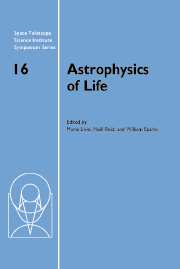 Astrophysics of Life
Astrophysics of Life Published online by Cambridge University Press: 29 August 2009
Gravitational microlensing offers a powerful technique to search for extra-solar planets around lensing stars via short-timescale amplifications produced by the planet on the microlensing lightcurve. This method is technologically simple, can be carried out with a network of relatively small ground-based telescopes, and is sensitive down to earth-mass planets.
More than 100 microlensing events towards the Galactic bulge have been monitored by the PLANET collaboration to look for such planetary signals. No clear planetary signal has been detected, which implies that less than 33% of the lensing stars have Jupiter-mass planets with orbital radii of 1.5–4 AU. Since other techniques are currently not sensitive to the outer portion of these orbital radii, these are the best current limits on extra-solar planets at these orbital separations.
Isolated planetary-mass objects can also reveal themselves as short timescale microlensing events in a monitoring program. Lack of such short-timescale events in the MACHO and EROS database towards the LMC suggests that the contribution of planetary-mass objects is less than 10% of the halo dark matter.
Gravitational microlensing as a tool
Uranus is roughly a 6th magnitude object, and is almost a naked-eye object. Yet it was discovered only in 1791, long after the telescope was invented, and it took a great astronomer like Sir William Herschel to do so (at least by some accounts). Uranus was the last planet to be discovered by its direct light.
To save this book to your Kindle, first ensure [email protected] is added to your Approved Personal Document E-mail List under your Personal Document Settings on the Manage Your Content and Devices page of your Amazon account. Then enter the ‘name’ part of your Kindle email address below. Find out more about saving to your Kindle.
Note you can select to save to either the @free.kindle.com or @kindle.com variations. ‘@free.kindle.com’ emails are free but can only be saved to your device when it is connected to wi-fi. ‘@kindle.com’ emails can be delivered even when you are not connected to wi-fi, but note that service fees apply.
Find out more about the Kindle Personal Document Service.
To save content items to your account, please confirm that you agree to abide by our usage policies. If this is the first time you use this feature, you will be asked to authorise Cambridge Core to connect with your account. Find out more about saving content to Dropbox.
To save content items to your account, please confirm that you agree to abide by our usage policies. If this is the first time you use this feature, you will be asked to authorise Cambridge Core to connect with your account. Find out more about saving content to Google Drive.